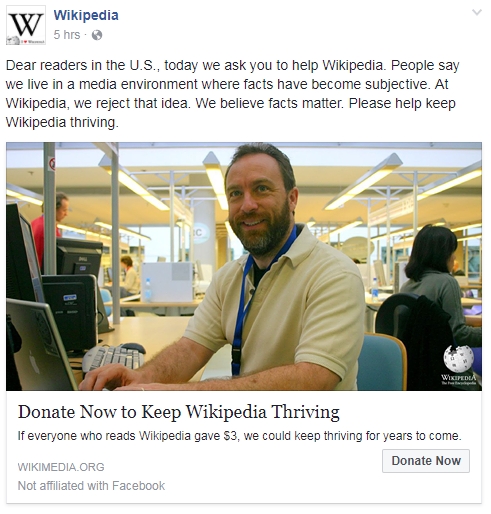Fundraising/Updates/FBAdsExperiment
Update: 7/14/17[edit]
On July 12th, 2017, we launched our FB ads experiment. Our first ad set consists of two variants, each using the same image of Jimmy Wales. Jimmy appeared in our high performing on-Wikipedia fundraising banners for quite a while, so it's logical to start there with our FB ads. For copy, we're testing a version adapted directly from our current best fundraising banners against a shorter version using the "Facts Matter" framing.
Early results look promising but we haven't collected enough data to make any verdicts. We still have the majority of our $5k initial budget left to spend and will continue a/b testing.
Regarding the target audiences we outlined in our initial proposal, the one trend we're seeing is that people who have liked our Facebook page also click thru our ads at a higher rate.
More info about the experiment[edit]
Where will the ads appear?
This pilot will use “sponsored posts,” which is what Facebook calls content that appears in the news feed of Facebook users. They will also appear on Instagram as “sponsored stories” that appear within the flow of photo and video posts users scroll on that network. (Instagram is a Facebook property.)
They will not appear as banners, pop-ups, or display ads that appear alongside the news feed. This is a test in what is called “native” advertising, meaning it uses the same content display area that users expect from Facebook and Instagram.
How will you target your ads?
In addition to the broad parameters of language (English) and country (U.S.), we have identified a few target audiences that might respond particularly well to our appeals: educators, philanthropists, and frequent consumers of news. We will build these audiences based off self reported information about educational achievement, news readership, and philanthropic interest. In addition to these, we have discussed the value of comparing effectiveness across other characteristics - age, gender, etc.
A large part of the value in running this experiment is to learn whether there are any demographic differences in how people respond to our messaging. If this experiment does give us compelling info about who is more likely to donate, that is exciting! And we'll talk as a group about what to do with that knowledge.
Can users opt out?
Of course. Users can hide individual ads if they are not of interest to them. This is also something we can measure to better understand how to not annoy or impose on social media users in future fundraising drives.
Who is working on this?
Fundraising is partnering with the social media folks in Communications to run this test. The promotion and measurement of ads is being managed by a small company called Middle Seat.
Will you keep us in the loop?
Absolutely. By July 15 we intend to share an overview of our testing so far. Stay tuned for more updates!


